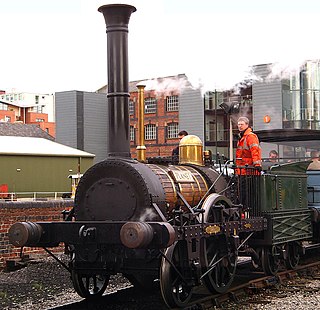
Under the Whyte notation for the classification of steam locomotives, 2-2-0 represents the wheel arrangement of two leading wheels on one axle, two powered driving wheels on one axle, and no trailing wheels. This configuration, which became very popular during the 1830s, was commonly called the Planet type after the first locomotive, Robert Stephenson's Planet of 1830.
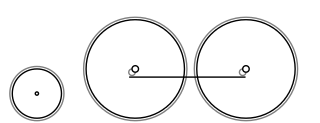
Under the Whyte notation for the classification of steam locomotives, 2-4-0 represents the wheel arrangement of two leading wheels on one axle, four powered and coupled driving wheels on two axles and no trailing wheels. In most of North America it became known as a Porter.
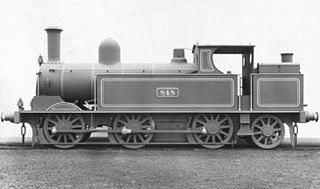
The London and North Western Railway (LNWR) Webb Coal Tank is a class of 0-6-2T steam locomotive. They were called "Coal Tanks" because they were a side tank version of Webb's standard LNWR 17in Coal Engine, an 0-6-0 tender engine for slow freight trains.
Under the Whyte notation for the classification of steam locomotives, 0-2-4 represents the wheel arrangement of no leading wheels, two powered driving wheels on one axle, and four trailing wheels on two axles.

The London and North Western Railway Experiment Class was a series of 30 three-cylinder 2-(2-2)-0 compound locomotives designed by Francis Webb for the London and North Western Railway between 1882 and 1884. They were Webb’s first large-scale experiment with a class of express compound locomotives, and the first engine was named accordingly. They were followed by a class of similar, but larger locomotives, that featured larger boilers and smaller driving wheels – the LNWR Dreadnought Class.
Under the Whyte notation for the classification of steam locomotives, 2-2-2-0 usually represents the wheel arrangement of two leading wheels on one axle, four powered but uncoupled driving wheels on two axles, and no trailing wheels, but can also be used to represent two sets of leading wheels two driving wheels, and no trailing wheels. Some authorities place brackets around the duplicated but uncoupled wheels, creating a notation 2-(2-2)-0, or (2-2)-2-0, as a means of differentiating between them. Others simply refer to the locomotives 2-2-2-0.
Under the Whyte notation for the classification of steam locomotives, 2-2-4-0T represents the wheel arrangement of two leading wheels on one axle, two driving wheels powered from the inside cylinders, four coupled driving wheels powered from the outside cylinders but no trailing wheels.
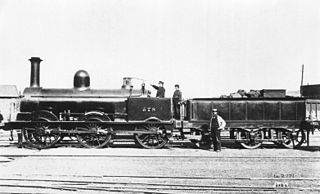
The London and North Western Railway (LNWR) DX Goods class was a class of 0-6-0 steam locomotive, designed by John Ramsbottom for freight duties. 943 were constructed, making them the largest single class of steam locomotives built in the United Kingdom. Despite this, none were preserved.
The Glasgow and South Western Railway (GSWR) 187 class were a class of 0-4-2 steam locomotives designed for mixed traffic duties, by James Stirling in 1870. They formed a model for large numbers of similar 0-4-2 mixed traffic locomotives subsequently built on GSWR and other British railways.
Under the Whyte notation for the classification of steam locomotives, 0-2-2-0 represents the wheel arrangement of no leading wheels, four powered but uncoupled driving wheels on two axles, and no trailing wheels. Some authorities place brackets around the duplicated but uncoupled wheels, creating a notation 0-(2-2)-0.

The LNWR Dreadnought class was a class of 40 passenger three-cylinder compound 2-2-2-0 locomotives designed by F. W. Webb for the London and North Western Railway, and manufactured by them in their Crewe Works between 1884 and 1888. The railway also commissioned the Beyer, Peacock and Company to construct an additional locomotive of the design for the Pennsylvania Railroad.

The LNWR Teutonic class was a class of 10 passenger three-cylinder compound 2-2-2-0 locomotives designed by F. W. Webb for the London and North Western Railway, and manufactured by them in their Crewe Works between 1889 and 1890.

The London and North Western Railway (LNWR) Precursor class was a class of forty 2-4-0 steam locomotives designed by F. W. Webb and built at the railway's Crewe Works between 1874 and 1879.
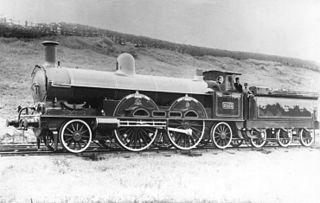
The London and North Western Railway (LNWR) Greater Britain class was a class of ten 2-2-2-2 steam locomotives designed for express passenger work by F. W. Webb.
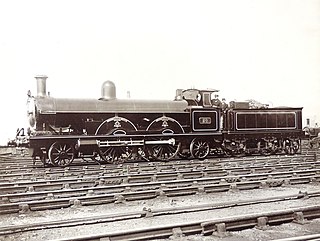
The London and North Western Railway (LNWR) John Hick class was a class of ten 2-2-2-2 steam locomotives designed for express passenger work by F. W. Webb.

The LNWR 18-inch Goods was a class of 310 0-6-0 freight steam locomotives built by the London and North Western Railway at their Crewe Works between 1880 and 1902.

The LNWR 18-inch Tank class was a class of 80 0-6-2T locomotives built by the London and North Western Railway in their Crewe Works between 1898 and 1902.

The LNWR 5ft 6in Tank was a class of 160 passenger 2-4-2T locomotives manufactured by the London and North Western Railway in their Crewe Works between 1890 and 1897. The "5ft 6in" in the title referred to the diameter of the driving wheels – although the stated dimension was for the wheel centres – the nominal diameter including the tyres was 5 ft 8+1⁄2 in (1,740 mm).

The LNWR Newton Class was a class of ninety-six 2-4-0 steam locomotives built by the London and North Western Railway at their Crewe Works between 1866 and 1873.

The LNWR Samson Class was a class of ninety 2-4-0 steam locomotives built by the London and North Western Railway at their Crewe Works between 1863 and 1879.

















